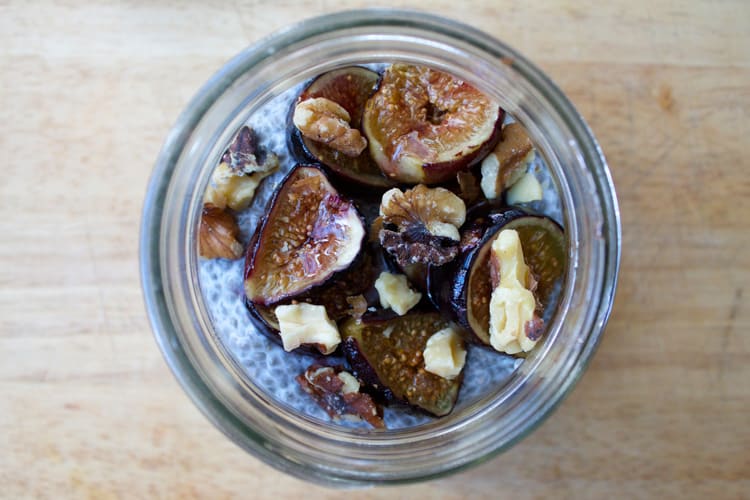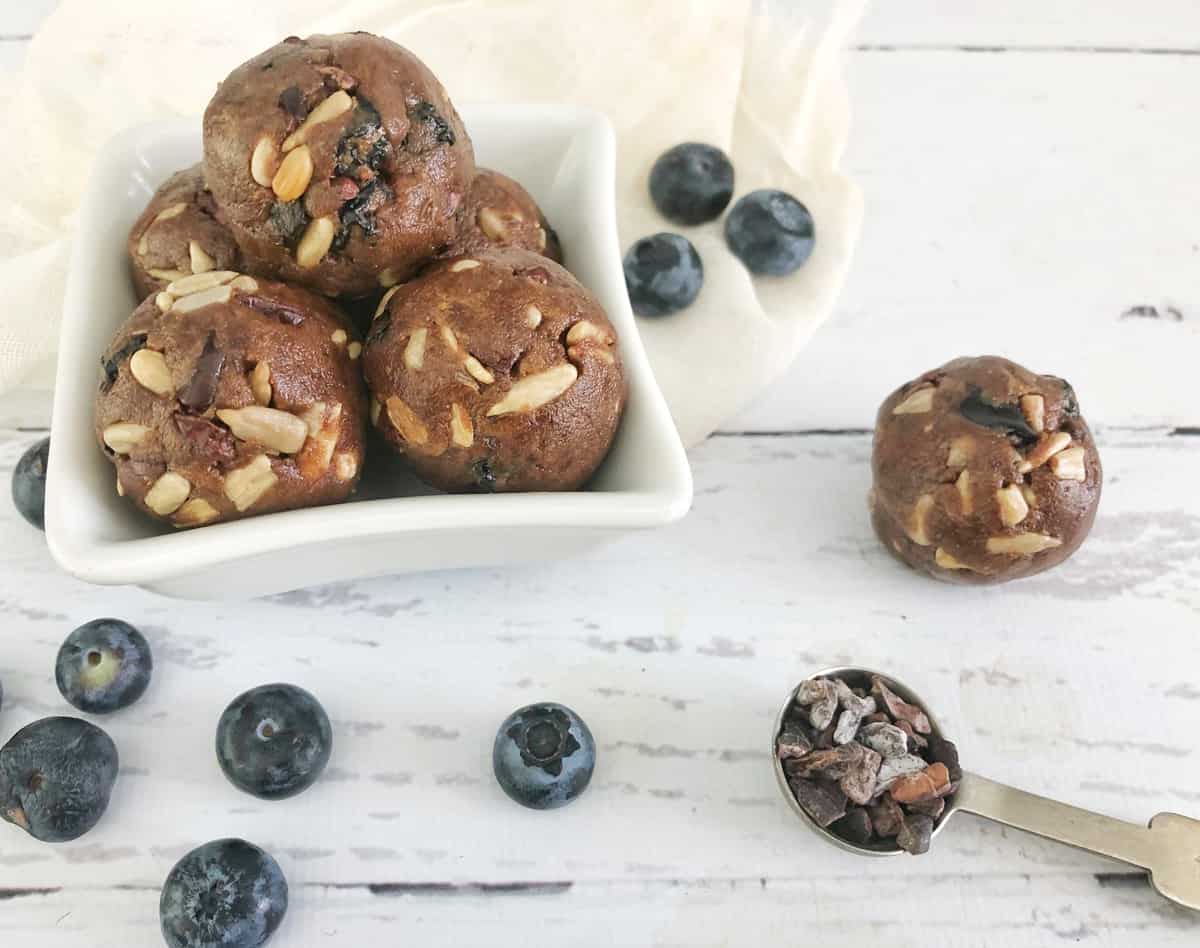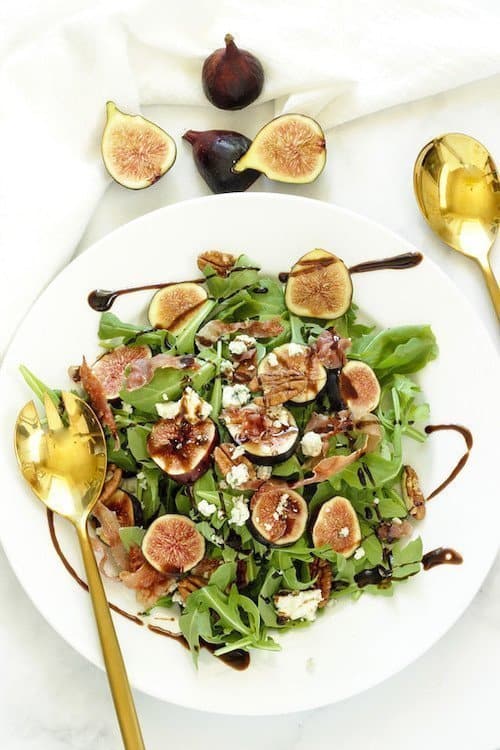Summer is coming to a close and fall is approaching which can only mean…figs are in season! This mysterious little fruit is soft, sweet, and super versatile in the kitchen! This guide is meant to help you feel more confident to purchase, store, and use figs in the kitchen. So if you’re ready to get figgy with it, read on!
Introduction: What are figs?
Figs are a fruit that grow on trees. These small fruits tend to look like a teardrop, and can be green, purple, brown, or black. On the other hand, the inside of figs are typically pink, fleshy, and seeded for an added satisfying crunch factor.
Figs come in many different varieties including:
- Black Mission: one of the most widely available varieties, this fig is small, and sticky sweet when ripe!
- Brown Turkey: these brown colored fruits are soft, heavy, sweet, and juicy when ripe!
- Sierra: this fig is green-skinned, large and round, and is ideal when sliced up.
- Calimyrna: this variety of fig is often dried, and has undertones of honey, jam, and butterscotch.
- King: another green variety, this fig has a dark purple flesh and has an amazing flavor when allowed to ripen!
- Kadota: a yellow-green skinned fig, this is one of the most commonly seen figs in the state of California.
- Tiger: green and yellow striped fruit, resembling a tiger’s fur, can have a raspberry-citrus flavor on the inside when ripe.
Figs typically flourish in dry and sunny terrains, such as the Mediterranean and Middle Eastern climates. In the United States, most figs are grown in California, which for most of the year mimics a sunny, Mediterranean climate. Figs can also be eaten fresh or dried.
Figs are known to have two seasons. The first season starts the first few weeks in June and lasts for a short period of time. The second is usually from August through October, lasting much longer than the first.
Fig Nutrition
Fresh figs are full of great nutrients including fiber, iron, calcium, magnesium, phosphorus, potassium, vitamin A, vitamin C, and zinc. These fruits have been known to promote digestive health, heart health and be able to help manage blood sugar levels. Certain varieties of figs, such as black mission, contain antioxidant properties that can protect your body against free radical compounds.
How to pick out figs at the grocery store
When selecting ripe figs, it’s important to look for a few key characteristics:
- Smooth, unbroken skin
- Soft to the touch (but not mushy)
- Still holding their round shape, not collapsed
When you pick the perfect batch of figs, be sure to keep them refrigerated once you bring them home to slow the spoiling process. For best results, use figs the same day that you purchase them!
How to use figs in the kitchen
Before using (or eating) your figs, be sure to rinse them in cool water and remove the stem at the top of the fruit. Fresh figs can be eaten raw, as they are, or they can be grilled, sautéed, or baked to enhance their natural flavors!
Figs tend to pair well with Mediterranean Cuisines, such as onion, garlic, and peppers. The flavor of figs also compliments salted and smoked meats such as prosciutto, ham, or turkey.
Other suggestions for using figs include:
- Slice and add to salads
- Roast with pork
- Pair with cheese such as goat, feta, or ricotta
- Use figs to constitute a fig simple syrup for a cocktail
- Pair with port wine
- Pair with nuts such as pistachios
To give you more inspiration for the kitchen, try one of these recipes using figs below!
You gettin’ figgy with it yet?
Recipes using figs:
Chia Pudding with Maple Roasted Figs and Toasted Walnuts via The Foodie Dietitian

Slow Cooker Fig Preserves via My Menu Pal
Chocolate Fig Bites via Fully Mediterranean
Brussels, Bacon and Fig Pizza via The Nutrition Adventure

Avocado, Fig and Feta Salad via Amanda Izquierdo Nutrition
Fig Ricotta and Almond Pizza via Nutrition Starring YOU
Dandelion Grilled Cheese with Fig and Brie via The Foodie Dietitian
BFF Bites via The Hormone Dietitian

Pumpkin and Fig Smoothie via Leanne Ray
Pumpkin Fig Pistachio Overnight Oats via Nutrition Starring YOU

Fig Energy Bars (No Bake and No Added Sugar) via Snacking in Sneakers
Dried Fig, Goat Cheese and Apple Galette via Better is the New Perfect
Fig and Arugula Salad with Blue Cheese and Prosciutto via Craving Something Healthy

Pork Tenderloin with Roasted Figs via Mom’s Kitchen Handbook
How to Make Fig Jam via Karen Buch
Fig and Oat Squares via BeeKay Nutrition
Healthy Homemade “Fig Newton” Cookies via Hungry Hobby
Figgy Apricot Spelt Bread via Fannetastic Food
For more recipe round ups just like this one, check out these below:




This is so timely. We are close to the end of our ‘2nd’ crop of figs (definitely the juiciest and sweetest of them). I’ve made jam. We’ve frozen quite a bit of them (2 gallon size bags filled to the brim-my husband likes them frozen as snacks). We’ve dehydrated many pounds (sliced) and snack on them during the season. I haven’t had time to make any pastries this year, but have made an almond cake with figs on top. We love figs! Thank you for sending this out!!
Oh YUM! That’s amazing. Love the idea of dehydrating them for snacks.
This was inspiring! I realized I have never, not once used a fig in my kitchen before, but this makes me want to try one of your recipes! Thanks for bringing my awareness to this mysterious food.
That makes me so happy to hear! Glad it inspired 🙂